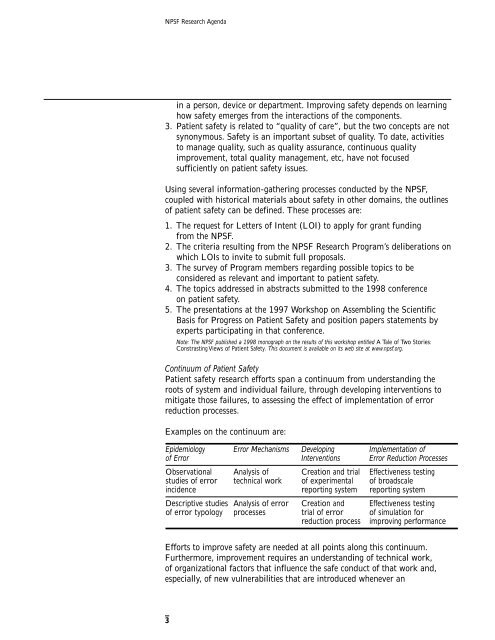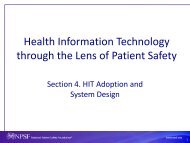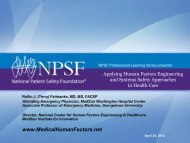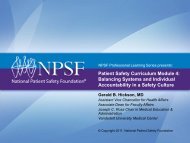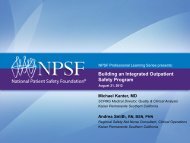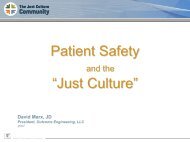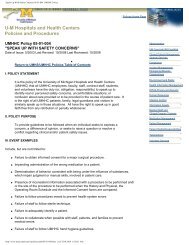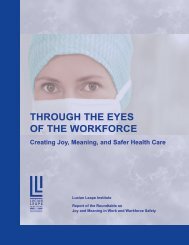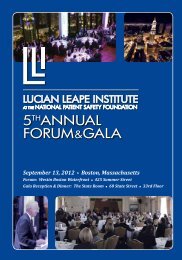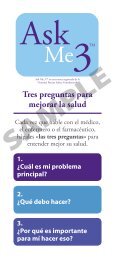Agenda for Research and Development in Patient Safety
Agenda for Research and Development in Patient Safety
Agenda for Research and Development in Patient Safety
- No tags were found...
You also want an ePaper? Increase the reach of your titles
YUMPU automatically turns print PDFs into web optimized ePapers that Google loves.
NPSF <strong>Research</strong> <strong>Agenda</strong><strong>in</strong> a person, device or department. Improv<strong>in</strong>g safety depends on learn<strong>in</strong>ghow safety emerges from the <strong>in</strong>teractions of the components.3. <strong>Patient</strong> safety is related to “quality of care”, but the two concepts are notsynonymous. <strong>Safety</strong> is an important subset of quality. To date, activitiesto manage quality, such as quality assurance, cont<strong>in</strong>uous qualityimprovement, total quality management, etc, have not focusedsufficiently on patient safety issues.Us<strong>in</strong>g several <strong>in</strong><strong>for</strong>mation-gather<strong>in</strong>g processes conducted by the NPSF,coupled with historical materials about safety <strong>in</strong> other doma<strong>in</strong>s, the outl<strong>in</strong>esof patient safety can be def<strong>in</strong>ed. These processes are:1. The request <strong>for</strong> Letters of Intent (LOI) to apply <strong>for</strong> grant fund<strong>in</strong>gfrom the NPSF.2. The criteria result<strong>in</strong>g from the NPSF <strong>Research</strong> Program’s deliberations onwhich LOIs to <strong>in</strong>vite to submit full proposals.3. The survey of Program members regard<strong>in</strong>g possible topics to beconsidered as relevant <strong>and</strong> important to patient safety.4. The topics addressed <strong>in</strong> abstracts submitted to the 1998 conferenceon patient safety.5. The presentations at the 1997 Workshop on Assembl<strong>in</strong>g the ScientificBasis <strong>for</strong> Progress on <strong>Patient</strong> <strong>Safety</strong> <strong>and</strong> position papers statements byexperts participat<strong>in</strong>g <strong>in</strong> that conference.Note: The NPSF published a 1998 monograph on the results of this workshop entitled A Tale of Two Stories:Constrast<strong>in</strong>g Views of <strong>Patient</strong> <strong>Safety</strong>. This document is available on its web site at www.npsf.org.Cont<strong>in</strong>uum of <strong>Patient</strong> <strong>Safety</strong><strong>Patient</strong> safety research ef<strong>for</strong>ts span a cont<strong>in</strong>uum from underst<strong>and</strong><strong>in</strong>g theroots of system <strong>and</strong> <strong>in</strong>dividual failure, through develop<strong>in</strong>g <strong>in</strong>terventions tomitigate those failures, to assess<strong>in</strong>g the effect of implementation of errorreduction processes.Examples on the cont<strong>in</strong>uum are:Epidemiology Error Mechanisms Develop<strong>in</strong>g Implementation ofof Error Interventions Error Reduction ProcessesObservational Analysis of Creation <strong>and</strong> trial Effectiveness test<strong>in</strong>gstudies of error technical work of experimental of broadscale<strong>in</strong>cidence report<strong>in</strong>g system report<strong>in</strong>g systemDescriptive studies Analysis of error Creation <strong>and</strong> Effectiveness test<strong>in</strong>gof error typology processes trial of error of simulation <strong>for</strong>reduction process improv<strong>in</strong>g per<strong>for</strong>manceEf<strong>for</strong>ts to improve safety are needed at all po<strong>in</strong>ts along this cont<strong>in</strong>uum.Furthermore, improvement requires an underst<strong>and</strong><strong>in</strong>g of technical work,of organizational factors that <strong>in</strong>fluence the safe conduct of that work <strong>and</strong>,especially, of new vulnerabilities that are <strong>in</strong>troduced whenever an3


